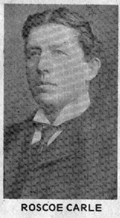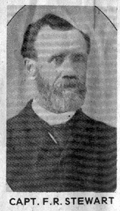April 7, 1983


Picture #1 – Roscoe Carle
Picture #2 – Capt. F.R. Stewart
Author’s Note: Today’s article may be entertaining, but it may cause readers to think seriously about the schools and the education of our youth after reading about teachers and schools of yesteryear.
What I wrote should not be introduced as advocating a return to methods of the past, but it may be that educators could take a few pages from the methods, practices, etc. of earlier days.
After reading today’s article, readers may understand that primary education then was gained without fancy buildings and special activities. The teachers’ low salaries didn’t detract from methods and results.
Captain F.R. Stewart who wrote the material which forms the text of today’s article, was a prominent Fostoria businessman and gave many years of his life to serving his church, the Presbyterian. He also served his country during the Civil War as captain of the 49th OVI. He died in 1922, about one year after attending his school reunion in 1921 which was the 18th anniversary of Possum Hill School.
Roscoe Carle who edited, printed and presented booklets which contained Stewart’s materials was editor and publisher of The Fostoria Times which later merged with The Fostoria Review.
Carle attended that same school in the 1870s. He presided at the 19th anniversary school reunion in 1930 and presented 100 booklets in the hopes the records would be preserved. A copy of the booklet from which material for this article was taken was purchased by Charles Mizen, Bascom. He bought it at a public sale and had a copy made for me. It will be preserved in my files.
A DAY AT POSSUM HILL SCHOOL IN 1842
Read by Captain F.R. Stewart at the annual reunion of the school on Sept. 24, 1921:
“I started to school at Possum Hill in October 1842 when I lacked two months of being seven-years-old. That was 79 years ago. Anybody in the arithmetic class will readily see that I am therefore nearly 86 years old. I claim to be 86 years young and to be just as certain to be at the school reunion in 1925 as the reunion is certain to be held.
“The school in that remote day was held in the log building built the year before in 1841, as described in the historical account I have also prepared for this occasion. It stood where we are assembled today in the midst of a dense forest, with no homes or farms in sight, no road and no paths except trails leading in every direction from the school door and marked by blazed trees. The school in the winter terms was attended by 30-40 pupils of all ages from seven to 21. The families were few in the district but each family was generally large, and the sons and daughters went until they were of age or until they married which was frequently several years earlier than 21. As time passed, there were more families but smaller in membership and the older pupils began stopping out to attend academies and colleges.
“Perhaps if I describe from memory a day at Possum Hill School in 1842, it will give you a truthful impression of early educational days.
Our parents in those days, the pioneer settlers in the woods, set the same value on education and were willing to make the same sacrifices for their children to obtain an education that every generation has done since. Neither they nor we had any intentions of going higher than the district school, although some of us did, but aimed to graduate into the humble and exacting life of our immediate environment.
“In my home as in the others, we rose at an early hour. I had my chores to do at the age of seven. I brought in the cows from pasture, fed the chickens and the pigs and carried in firewood if needed. Meanwhile, my sisters milked the cows. A typical breakfast consisted of scalded mush and milk left over from summer. Cracked hominy figured in this diet, which braced up considerably after butchering when we had sausage and spareribs. All the scholars carried their noonday lunches to school. I lived nearly a mile east of the school house, and we followed the trail marked by the blazes or gashes on the trees. When the snow was deep, my father broke a path by taking two of the horses, mounting one with me behind and leading the other with my two sisters on. When he returned home over the same path it was broken enough for us to walk home in the evening. The scholars were punctual, except when the weather was stormy. We hung our dinner pails on long pins high up on the wall and the girls hung their shawls on pegs. The boys had no overcoats to hang up. The boys had seats on the north side of the room, the girls on the south. There were benches at the back or west end for the larger pupils and plank shelves for writing, also a blackboard between the windows. The seats were made from slabs obtained from Uriah Egbert’s sawmill west of the school house. The writing desks, of two-inch planks two feet wide, were braced against the walls: the smaller pupils had similar benches set lower near the stove.
“The stove, made of iron shaped like a huge box, was in the center with the pipe going straight up through the roof. Each family was required to furnish wood according to the number of pupils from the family. The Earl, the Park and the Goetschlus families were large and had to do considerable chopping. The stove kept the room comfortable.
“The branches studied were the common branches: spelling, reading, arithmetic and writing. When a parent wanted his children to know something about history, the pupil would bring a book to school and read aloud from it instead of from a reader. The Bible was studied by several pupils in my time in this manner. Great stress was laid on spelling and penmanship. I had learned the alphabet and knew how to spell a few simple words when I started. Many children got their first instruction in their ABC’s in the school. In the spelling class, a missed word was passed on, and each afternoon the pupil at the head of the line in each of the two classes “left off head” and a record was kept of this during the term. A girl named Margaret Taylor and myself were champions for awhile and equal. We never passed each other, but she got one more credit at the end of the term than I did, gaining the odd day and the prize.
“We wrote with quill pens made from goose quills. The teacher set the copy and sharpened the pens. It took a good deal of his time. The teacher was not posted on sanitation or ventilation, but in pioneer days we had plenty of both without knowing either.
“We were taught and we studied on about the same principles that schools are conducted on today. We played at noon and recess. The boys played at corner ball and later at town hall. The girls played in game where circles were formed. The boys liked to be sent after water. Two went at a time during school hours. A spring in a ravine back of the school house about 40 rods distant, where deer used to drink was our source of supply. Thomas Park and I went one time on the way back loitered under a thorn tree gathering a lot of thorns and had to go back and fill the pail again. The teacher asked for an explanation of our delay and I told him that we had the misfortune to spill the water and this satisfied him. I did not tell him about the loitering. We sat behind a row of boys whose coattails hung down behind their bench. We thought it would be a good idea to pin the tails together with our thorns, which we did. A small boy named Houck laughed out loud and the teacher demanded the reason for his mirth. “I was laughing at Frank and Tom,” he said. The teacher soon detected the cause and we were forced to withdraw our imprisoned pins.” Continued next week.
Author’s Note: After this article was written and too late to revise, I learned from Raymond Gaietto, county school superintendent, that John Buskirk, Seneca County Road 37, recalls the demise of Possum Hill School. He told me that in about 1968 when it was being used as a residence it was destroyed by fire. Where the school once sat, there is not a mobile home. The building was no longer used as a school after 1938 or 1939. At that time, the students going there were bussed into Tiffin.